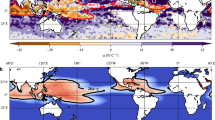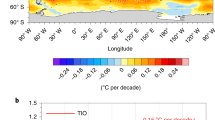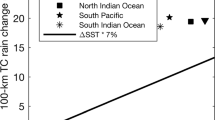Abstract
Rainfall in the tropics is largely focused in a narrow zonal band near the Equator, known as the intertropical convergence zone. On average, substantially more rain falls just north of the Equator1. This hemispheric asymmetry in tropical rainfall has been attributed to hemispheric asymmetries in ocean temperature induced by tropical landmasses. However, the ocean meridional overturning circulation also redistributes energy, by carrying heat northwards across the Equator. Here, we use satellite observations of the Earth’s energy budget2, atmospheric reanalyses3 and global climate model simulations to study tropical rainfall using a global energetic framework. We show that the meridional overturning circulation contributes significantly to the hemispheric asymmetry in tropical rainfall by transporting heat from the Southern Hemisphere to the Northern Hemisphere, and thereby pushing the tropical rain band north. This northward shift in tropical precipitation is seen in global climate model simulations when ocean heat transport is included, regardless of whether continents are present or not. If the strength of the meridional overturning circulation is reduced in the future as a result of global warming, as has been suggested4, precipitation patterns in the tropics could change, with potential societal consequences.
This is a preview of subscription content, access via your institution
Access options
Subscribe to this journal
Receive 12 print issues and online access
$259.00 per year
only $21.58 per issue
Buy this article
- Purchase on Springer Link
- Instant access to full article PDF
Prices may be subject to local taxes which are calculated during checkout



Similar content being viewed by others
References
Huffman, G. J., Adler, R. F., Bolvin, D. T. & Gu, G. Improving the global precipitation record: GPCP Version 2.1. Geophys. Res. Lett. 36, L17808 (2009).
Wielicki, B. A. et al. Clouds and the Earth’s radiant energy system (CERES): An Earth observing system experiment. Bull. Am. Meteorol. Soc. 77, 853–868 (1996).
Dee, D. P. et al. The ERA-Interim reanalysis: Configuration and performance of the data assimilation system. Q. J. R. Meteorol. Soc. 137, 553–597 (2011).
Weaver, A. J. et al. Stability of the Atlantic meridional overturning circulation: A model intercomparison. Geophys. Res. Lett. 39, L20709 (2012).
Hadley, G. Concerning the cause of the general trade winds. Phil. Trans. R. Soc 29, 58–62 (1735).
Dima, I. M. & Wallace, J. M. On the seasonality of the Hadley Cell. J. Atmos. Sci. 60, 1522–1527 (2003).
Frierson, D. M. W. & Hwang, Y-T. Extratropical influence on ITCZ shifts in slab ocean simulation of global warming. J. Clim. 25, 720–733 (2012).
Hwang, Y-T. & Frierson, D. M. W. A new look at the double ITCZ problem: Connections to cloud bias over the Southern Ocean. Proc. Natl Acad. Sci. USA 110, 4935–4940 (2013).
Hwang, Y-T., Frierson, D. M. W. & Kang, S. M. Anthropogenic sulfate aerosol and the southward shift of tropical precipitation in the 20th century. Geophys. Res. Lett. 40, 1–6 (2013).
Chiang, J. C. H. & Bitz, C. M. Influence of high latitude ice cover on the marine Intertropical Convergence Zone. Clim. Dynam. 25, 477–496 (2005).
Zhang, R. & Delworth, T. L. Simulated tropical response to a substantial weakening of the Atlantic thermohaline circulation. J. Clim. 18, 1853–1860 (2005).
Kang, S. M., Held, I. M., Frierson, D. M. W & Zhao, M. The response of the ITCZ to extratropical thermal forcing: Idealized slab-ocean experiments with a GCM. J. Clim. 21, 3521–3532 (2008).
Yoshimori, M. & Broccoli, A. J. On the link between Hadley circulation changes and radiative feedback processes. Geophys. Res. Lett. 36, L20703 (2009).
Fučkar, N. S., Xie, S-P., Farneti, R., Maroon, E. A. & Frierson, D. M. W. Influence of the extratropical ocean circulation on the intertropical convergence zone in an idealized coupled general circulation model. J. Clim. 26, 4612–4629 (2013).
Voigt, A., Stevens, B., Bader, J. & Mauritsen, T. The observed hemispheric symmetry in reflected shortwave irradiance. J. Clim. 26, 468–477 (2013).
Marshall, J. & Speer, K. Closure of the meridional overturning circulation through Southern Ocean upwelling. Nature Geosci. 5, 171–180 (2012).
Lumpkin, R. & Speer, K. Global ocean meridional overturning. J. Phys. Oceanogr. 37, 2550–2562 (2007).
Marshall, J., Donohoe, A., Ferreira, D. & McGee, D. The role of the ocean circulation in setting the mean position of the ITCZ. Clim. Dyn.http://dx.doi.org/10.1007/s00382-013-1767-z (2013).
Song, X. & Zhang, G. J. Convection parameterization, tropical Pacific double ITCZ, and upper ocean biases in the NCAR CCSM3. Part II: Coupled feedback and the role of ocean heat transport. J. Clim. 23, 800–812 (2010).
Xie, S-P. & Philander, S. G. H. A coupled ocean-atmosphere model of relevance to the ITCZ in the eastern Pacific. Tellus 46A, 340–350 (1994).
Takahashi, K. & Battisti, D. S. Processes controlling the mean tropical pacific precipitation pattern. part I: The Andes and the eastern Pacific ITCZ. J. Clim. 20, 3434–3451 (2007).
DeMenocal, P. B et al. Abrupt onset and termination of the African Humid Period: Rapid climate response to gradual insolation forcing. Quat. Sci. Rev. 19, 347–361 (2000).
IPCC Climate Change 2007: The Physical Science Basis (eds Solomon, S. et al.) (Cambridge Univ. Press, 2007).
Trenberth, K. E. & Fasullo, J. T. An observational estimate of ocean energy divergence. J. Phys. Oceanogr. 38, 984–999 (2008).
Anderson, J. L. et al. The new GFDL global atmosphere and land model AM2–LM2: Evaluation with prescribed SST simulations. J. Clim. 17, 4641–4673 (2004).
Acknowledgements
We acknowledge helpful conversations with L. Thompson, C. Bitz, K. Armour, B. Rose, I. Held, R. Pierrehumbert, D. Hartmann, J. Scheff and M. Wallace. J. Fasullo provided the ERA-Interim energy transports. We acknowledge the Program for Climate Model Diagnosis and Intercomparison and the WCRP’s Working Group on Coupled Modelling for their roles in making available the CMIP3 and CMIP5 data sets. D.M.W.F. and Y-T.H. are supported by NSF Grants AGS-0846641 and AGS-0936069, and a University of Washington Royalty Research Fund grant. N.S.F. is supported by the Japan Agency for Marine-Earth Science and Technology (JAMSTEC), by NASA through grant No. NNX07AG53G, and by NOAA through grant No. NA11NMF4320128, which sponsor research at the International Pacific Research Center. R.S. is supported by NSF award AGS-0804107. S.M.K. is supported by the Basic Science Research Program through the National Research Foundation of Korea (NRF) funded by the Ministry of Science, ICT and Future Planning (2013R1A1A3004589). A.D. is supported by the NOAA Climate and Global Change Fellowship, administered by the University Corporation for Atmospheric Research. E.A.M. is supported by the National Defense Science and Engineering Graduate Fellowship Program.
Author information
Authors and Affiliations
Contributions
D.M.W.F., N.S.F. and Y-T.H. designed the original diagnostics and experiments, with frequent subsequent input on diagnostic techniques and experimental design from all co-authors. Y-T.H. and D.M.W.F. analysed the observations. Y-T.H. performed experiments with the GFDL model. X.L. and D.S.B. designed experiments with the ECHAM model, and X.L. ran the ECHAM model experiments. D.M.W.F. led the writing of the paper, with substantial input from all co-authors.
Corresponding author
Ethics declarations
Competing interests
The authors declare no competing financial interests.
Supplementary information
Supplementary Information
Supplementary Information (PDF 874 kb)
Rights and permissions
About this article
Cite this article
Frierson, D., Hwang, YT., Fučkar, N. et al. Contribution of ocean overturning circulation to tropical rainfall peak in the Northern Hemisphere. Nature Geosci 6, 940–944 (2013). https://doi.org/10.1038/ngeo1987
Received:
Accepted:
Published:
Issue Date:
DOI: https://doi.org/10.1038/ngeo1987
This article is cited by
-
The central role of the Atlantic meridional overturning circulation in the Bjerknes compensation
Climate Dynamics (2024)
-
Present-day North Atlantic salinity constrains future warming of the Northern Hemisphere
Nature Climate Change (2023)
-
Human-induced weakening of the Northern Hemisphere tropical circulation
Nature (2023)
-
Constrained tropical land temperature-precipitation sensitivity reveals decreasing evapotranspiration and faster vegetation greening in CMIP6 projections
npj Climate and Atmospheric Science (2023)
-
Changes in Sahel summer rainfall in a global warming climate: contrasting the mid-Pliocene and future regional hydrological cycles
Climate Dynamics (2023)



